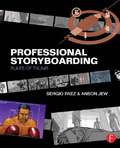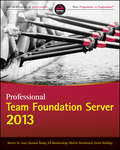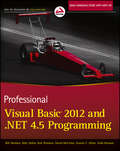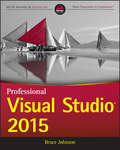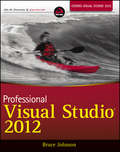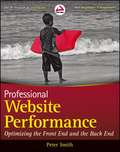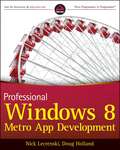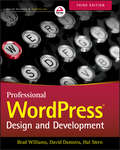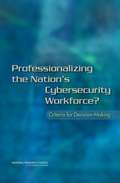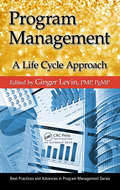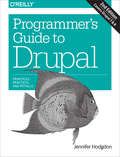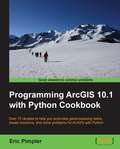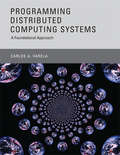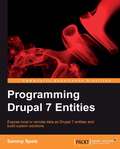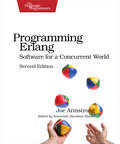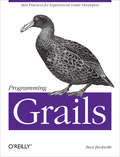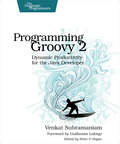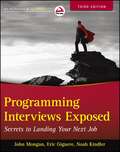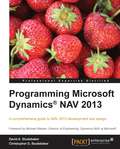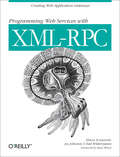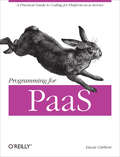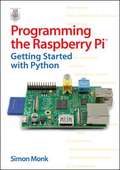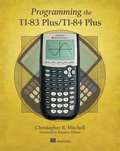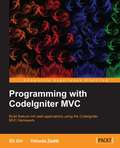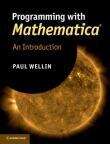- Table View
- List View
Professional Storyboarding: Rules of Thumb
by Anson JewStoryboarding is a very tough business, and a new storyboarder really needs to have their wits about them and have professional savvy to survive in this competitive field. Storyboarding: Rules of Thumb offers highly illustrative examples of basic storyboarding concepts, as well as sound, career-oriented advice for the new artist. This book also features a number of veteran storyboard artists sharing their experiences in the professional world.
Professional Team Foundation Server 2013
by Martin Woodward Grant Holliday Ed Blankenship Steven St. Jean Damian BradyTeam Foundation Server is now for everyone!Team Foundation Server is an integral part of Microsoft's Application Lifecycle Management suite for managing and delivering software projects. The 2013 update has opened up TFS for everyone by expanding capabilities to support iOS, MacOS, Android, and Java development. Professional Team Foundation Server 2013 covers the latest updates for Agile Project Management, Test-Case Management, Release Management, and shows new users the TFS workflow for managing and delivering products. The authors leverage their positions as MVP Microsoft insiders to guide you step-by-step through all things TFS, as well as help prepare you for the Team Foundation Server Certification Exam.Provides a broad overview of Team Foundation Server for developers, software project managers, testers, business analysts, and others wanting to learn how to use TFSGives TFS administrators the tools they need to efficiently monitor and manage the TFS environmentCovers core TFS functions including project management, work item tracking, version control, test case management, build automation, reportingExplains extensibility options and how to write extensions for TFSHelps certification candidates prepare for the Microsoft Team Foundation Server 2013 certification examProfessional Team Foundation Server 2013 is the ultimate guide to mastering this invaluable developer's tool.
Professional Visual Basic 2012 and .NET 4.5
by Bill Sheldon Billy Hollis Rob Windsor David Mccarter Gaston Hillar Todd HermanExplore Visual Basic 2012 and . NET 4. 5 with this fully updated resource After a quick review of the of introductory topics of Visual Basic 2012 and . NET 4. 5, this book moves quickly into advanced topics such as data access with ADO. NET, security, ASP. NET web programming with Visual Basic, Windows workflow, and threading. You'll explore the essential Visual Basic 2012 functions you need, including . NET features such as LINQ, WCF, and more. Plus, you'll examine exception handling and debugging, Visual Studio features, and deployment. Puts the new Async keyword and Iterators to work Explores new options and interfaces presented by Windows 8 development and WinRT Continues strong coverage of core language elements and tools and creating componentized applications This updated version of Professional Visual Basic 2012 and . NET 4. 5 retains its expert author team, including one of the best-known and respected Microsoft Visual Basic MVPs, Bill Sheldon, and Microsoft Regional Director "Software Legend" Billy Hollis.
Professional Visual Studio 2012
by Bruce JohnsonThe ultimate developers' guide to Visual Studio 2012This expert Wrox guide is what you need to get up and running quickly on Visual Studio 2012. Written by a Microsoft Visual C# MVP, it guides you through the integrated development environment (IDE), showing you how to maximize all new tools and improvements.Offers programmers a fast way to IDE-centric programming success Demonstrates new IDE features, including the new Metro style app project templates and Windows 8 app store features Explains each feature, then illustrates the context in which it will help you solve problems Covers timely and essential topics related to rich client app development, web applications, application services, file configuration, debugging and testing, and more Helps advanced users customize and extend Visual Studio through the Automation Model, writing macros, working with the Managed Extensibility Framework (MEF), and more Provides ample detail for programmers who are new to Visual Studio 2012, as well as for experienced programmers exploring the advanced capabilities of the IDEProfessional Visual Studio 2012 uses a unique, IDE-centric approach to help you get up and running quickly on this exciting new release.
Professional Visual Studio 2012
by Bruce JohnsonThe ultimate developers' guide to Visual Studio 2012 This expert Wrox guide is what you need to get up and running quickly on Visual Studio 2012. Written by a Microsoft Visual C# MVP, it guides you through the integrated development environment (IDE), showing you how to maximize all new tools and improvements. Offers programmers a fast way to IDE-centric programming success Demonstrates new IDE features, including the new Metro style app project templates and Windows 8 app store features Explains each feature, then illustrates the context in which it will help you solve problems Covers timely and essential topics related to rich client app development, web applications, application services, file configuration, debugging and testing, and more Helps advanced users customize and extend Visual Studio through the Automation Model, writing macros, working with the Managed Extensibility Framework (MEF), and more Provides ample detail for programmers who are new to Visual Studio 2012, as well as for experienced programmers exploring the advanced capabilities of the IDE Professional Visual Studio 2012 uses a unique, IDE-centric approach to help you get up and running quickly on this exciting new release.
Professional Website Performance
by Peter SmithAchieve optimal website speed and performance with this Wrox guideEffective website development requires optimum performance with regard to both web browser and server. This book covers all aspects of building and maintaining websites that deliver peak performance on all levels. Exploring both front-end and back-end configuration, it examines factors like compression and JavaScript, database performance, MySQL tuning, NoSQL alternatives, load-balancing across multiple servers, effective caching of web contents, CSS, and much more. Both developers and system administrators will find value in this platform-neutral guide.Covers essential information for creating and maintaining websites that deliver peak performance on both front end and back endExplains how to configure front-end performance related to the web browser and how to speed up communication between server and browserTopics include MySQL tuning, NoSQL alternatives, CSS, JavaScript, and web imagesExplores how to minimize the performance penalties of SSL; load-balancing across multiple servers with Apache, Nginx, and MySQL; and effective caching and compression of web contents Professional Website Performance: Optimizing the Front End and Back End offers essential information to help both front-end and back-end technicians ensure better website performance.
Professional Windows 8 Programming
by Doug Holland Allen Sanders Kevin Ashley Nick LecrenskiIt is an exciting time to be a Windows developer. The arrival of Windows 8 is a complete game changer. The operating system and its development platform offer you an entirely new way to create rich, full-featured Windows-based applications. This team of authors takes you on a journey through all of the new development features of the Windows 8 platform specifically how to utilize Visual Studio 2012 and the XAML/C# languages to produce robust apps that are ready for deployment in the new Windows Store.Professional Windows 8 Programming:Learn how to utilize XAML to create rich content driven user interfacesMake use of the new AppBar to create a chrome-less menu systemSee how to support Sensors and Geo-location on Windows 8 devicesIntegrate your app into the Windows 8 ecosystem with Contracts and ExtensionsWalks you through the new Windows 8 navigation system for multi-page appsMinimize code with Data Binding and MVVM design patternsFeatures tips on getting your app ready for the Windows storeMaximize revenue for your app by learning about available monetization strategies
Professional WordPress
by Hal Stern Brad Williams David DamstraThe highly praised resource returns with updated content, examples, and code downloadsWordPress is the most popular self-hosted open source website software in use today, and the latest version makes it even simpler to operate. Packed with real-world examples for load balancing and multiusers, this esteemed resource replaces some of the more basic material with more advanced content. Every single chapter has been reworked to provide the most current and proper methods for developing and designing in WordPress. Coverage of HTML5, CSS3, and JavaScript and new chapters on custom post types, custom taxonomies, Multisite, and extensions of themes bring the content of this book completely up-to-date and provides you with all you need to deploy successful WordPress sites.Offers an overview of the WordPress system and describes what happens when a WordPress-generated web page is displayedDemonstrates extending WordPress through plugins and customizing it via themesCombines a developer view of user experience and optimization with the deployment requirements for performance, security, and measurementIncludes code downloads and code samples from the book's websiteYou'll be hard pressed to find a reliable resource with more advanced content than Professional WordPress, Second Edition!
Professionalizing the Nation's Cybersecurity Workforce?
by National Research Council Computer Science and Telecommunications Board Division on Engineering and Physical Sciences Committee on Professionalizing the Nation's Cybersecurity Workforce: Criteria for Future Decision-MakingProfessionalizing the Nation's Cybersecurity Workforce? Criteria for Decision-Making considers approaches to increasing the professionalization of the nation's cybersecurity workforce. This report examines workforce requirements for cybersecurity and the segments and job functions in which professionalization is most needed; the role of assessment tools, certification, licensing, and other means for assessing and enhancing professionalization; and emerging approaches, such as performance-based measures. It also examines requirements for the federal (military and civilian) workforce, the private sector, and state and local government. The report focuses on three essential elements: (1) understanding the context for cybersecurity workforce development, (2) considering the relative advantages, disadvantages, and approaches to professionalizing the nation's cybersecurity workforce, and (3) setting forth criteria that can be used to identify which, if any, specialty areas may require professionalization and set forth criteria for evaluating different approaches and tools for professionalization. Professionalizing the Nation's Cybersecurity Workforce? Criteria for Decision-Making characterizes the current landscape for cybersecurity workforce development and sets forth criteria that the federal agencies participating in the National Initiative for Cybersecurity Education--as well as organizations that employ cybersecurity workers--could use to identify which specialty areas may require professionalization and to evaluate different approaches and tools for professionalization.
Program Management: A Life Cycle Approach (Best Practices In Portfolio, Program, And Project Management Ser.)
by Pmp Ginger Levin PgMPProgram management is a rapidly emerging offshoot of project management. So much so that AT&T, IBM, and other organizations, both large and small in all sectors, have initiated a push to certify program managers. And, although universities offer courses in program management, there are few books available to guide program managers through this
Programmer's Guide to Drupal: Principles, Practices, and Pitfalls
by Jennifer HodgdonIf you’re a web programmer, your experiences have taught you certain lessons—and only some of them apply well to Drupal. Drupal has its own set of programming principles that require a different approach, and many programmers make mistakes when relying on skills they’ve used for other projects. This book will show you which programming techniques you can use—and which you should avoid—when building web applications with this popular content management framework. Updated to cover both Drupal 7 and Drupal 8, the guidelines in this book demonstrate which programming practices conform to the "Drupal way" and which don’t. The book also serves as an excellent guide for Drupal 7 programmers looking to make the transition to Drupal 8. Get an overview of Drupal, including Drupal core and add-on modules and themesLearn Drupal’s basic programming principles, such as the ability to customize behavior and output with hooksCompare Drupal 7 and Drupal 8 programming methods, APIs, and conceptsDiscover common Drupal programming mistakes—and why hacking is one of themExplore specific areas where you can put your programming skills to workLearn about the new object-oriented Drupal 8 API, including plugins and services
Programming ArcGIS 10.1 with Python Cookbook
by Eric PimplerThis book is written in a helpful, practical style with numerous hands-on recipes and chapters to help you save time and effort by using Python to power ArcGIS to create shortcuts, scripts, tools, and customizations."Programming ArcGIS 10.1 with Python Cookbook" is written for GIS professionals who wish to revolutionize their ArcGIS workflow with Python. Basic Python or programming knowledge is essential(?).
Programming Distributed Computing Systems: A Foundational Approach
by Carlos A. VarelaAn introduction to fundamental theories of concurrent computation and associated programming languages for developing distributed and mobile computing systems.Starting from the premise that understanding the foundations of concurrent programming is key to developing distributed computing systems, this book first presents the fundamental theories of concurrent computing and then introduces the programming languages that help develop distributed computing systems at a high level of abstraction. The major theories of concurrent computation—including the π-calculus, the actor model, the join calculus, and mobile ambients—are explained with a focus on how they help design and reason about distributed and mobile computing systems. The book then presents programming languages that follow the theoretical models already described, including Pict, SALSA, and JoCaml. The parallel structure of the chapters in both part one (theory) and part two (practice) enable the reader not only to compare the different theories but also to see clearly how a programming language supports a theoretical model.The book is unique in bridging the gap between the theory and the practice of programming distributed computing systems. It can be used as a textbook for graduate and advanced undergraduate students in computer science or as a reference for researchers in the area of programming technology for distributed computing. By presenting theory first, the book allows readers to focus on the essential components of concurrency, distribution, and mobility without getting bogged down in syntactic details of specific programming languages. Once the theory is understood, the practical part of implementing a system in an actual programming language becomes much easier.
Programming Drupal 7 Entities
by Sammy SpetsThe book follows a standard tutorial-based approach to create, retrieve, update, and delete Drupal 7 entities, their properties and fields.Programming Drupal 7 Entities is perfect for intermediate or advanced developers new to Drupal entity development who are looking to get a good grounding in how to code using the new paradigm. It's assumed that you will have some experience in PHP development already, and being vaguely familiar with Drupal, GIT, and Drush will also help.
Programming Erlang: Software for a Concurrent World
by Joe ArmstrongA multi-user game, web site, cloud application, or networked database can have thousands of users all interacting at the same time. You need a powerful, industrial-strength tool to handle the really hard problems inherent in parallel, concurrent environments. You need Erlang. In this second edition of the bestselling Programming Erlang, you'll learn how to write parallel programs that scale effortlessly on multicore systems.Using Erlang, you'll be surprised at how easy it becomes to deal with parallel problems, and how much faster and more efficiently your programs run. That's because Erlang uses sets of parallel processes-not a single sequential process, as found in most programming languages. Joe Armstrong, creator of Erlang, introduces this powerful language in small steps, giving you a complete overview of Erlang and how to use it in common scenarios. You'll start with sequential programming, move to parallel programming and handling errors in parallel programs, and learn to work confidently with distributed programming and the standard Erlang/Open Telecom Platform (OTP) frameworks. You need no previous knowledge of functional or parallel programming. The chapters are packed with hands-on, real-world tutorial examples and insider tips and advice, and finish with exercises for both beginning and advanced users.The second edition has been extensively rewritten. New to this edition are seven chapters covering the latest Erlang features: maps, the type system and the Dialyzer, WebSockets, programming idioms, and a new stand-alone execution environment. You'll write programs that dynamically detect and correct errors, and that can be upgraded without stopping the system. There's also coverage of rebar (the de facto Erlang build system), and information on how to share and use Erlang projects on github, illustrated with examples from cowboy and bitcask.Erlang will change your view of the world, and of how you program. What You NeedThe Erlang/OTP system. Download it from erlang.org.
Programming Grails: Best Practices for Experienced Grails Developers
by Burt BeckwithDig deeper into Grails architecture and discover how this application framework works its magic. Written by a core developer on the Grails team, this practical guide takes you behind the curtain to reveal the inner workings of its 2.0 feature set. You’ll learn best practices for building and deploying Grails applications, including performance, security, scaling, tuning, debugging, and monitoring.Understand how Grails integrates with Groovy, Spring, Hibernate, and other JVM technologies, and learn how to create and use plugins to augment your application’s functionality. Once you know how Grails adds behavior by convention, you can solve problems more easily and develop applications more intuitively.Write simpler, more powerful code with the Groovy languageManage persistence in Grails, using Hibernate or a NoSQL datastoreLearn how Grails uses Spring’s functionality and optional modulesDiscover how Hibernate handles details for storing and retrieving dataIntegrate technologies for messaging, mail, creating web services, and other JEE technologiesBypass convention and configure Grails manuallyLearn a general approach to upgrading applications and pluginsUse Grails to develop and deploy IaaS and PaaS applications
Programming Groovy 2: Dynamic Productivity for the Java Developer
by Venkat SubramaniamGroovy brings you the best of both worlds: a flexible, highly productive, agile, dynamic language that runs on the rich framework of the Java Platform. Groovy preserves the Java semantics and extends the JDK to give you true dynamic language capabilities. Programming Groovy 2 will help you, the experienced Java developer, learn and take advantage of the latest version of this rich dynamic language. You'll go from the basics of Groovy to the latest advances in the language, including options for type checking, tail-call and memoization optimizations, compile time metaprogramming, and fluent interfaces to create DSLs. You don't have to leave the rich Java Platform to take advantage of Groovy. Groovy preserves Java's semantics and extends the JDK, so programming in Groovy feels like the Java language has been augmented; it's like working with a lighter, more elegant Java. If you're an experienced Java developer who wants to learn how Groovy works, you'll find exactly what you need in this book.You'll start with the fundamentals of programming in Groovy and how it works with Java, and then you'll explore advanced concepts such as unit testing with mock objects, using Builders, working with databases and XML, and creating DSLs. You'll master Groovy's powerful yet complex run-time and compile-time metaprogramming features.Much has evolved in the Groovy language since the publication of the first edition of Programming Groovy. Programming Groovy 2 will help you learn and apply Groovy's new features. Creating DSLs is easier now, and Groovy's already-powerful metaprogramming facilities have improved even more. You'll see how to work with closures, including tail call optimization and memoization. The book also covers Groovy's new static compilation feature.Whether you're learning the basics of the language or interested in getting proficient with the new features, Programming Groovy 2 has you covered.What You NeedTo work on the examples in the book you need Groovy 2.0.5 and Java JDK 5 or higher.
Programming Interviews Exposed
by John Mongan Eric Giguere Noah KindlerBe prepared for your next job interview with this tried-and-true adviceIn today's tight job market, competition for programming jobs is hotter than ever. This third edition of a popular guide to programming interviews includes new code examples, information on the latest languages, new chapters on sorting and design patterns, tips on using LinkedIn, and a downloadable app to help prepare applicants for the interview. Like its earlier editions, this guide covers what software companies and IT departments want their programmers to know and includes plenty of helpful hints to boost your confidence. Looks at current job search and hiring processes, such as the rise of LinkedIn and other social networks as recruiting resourcesAddresses the most important languages for a programmer to know and features examples in multiple languagesIncludes new programming questions designed to sharpen your knowledgeFeatures all-new chapters on design patterns and sorting, including how to deal with memory constraints and mobility issuesWalk into your next job interview with confidence, knowing you have thoroughly studied this newest edition of Programming Interviews Exposed.
Programming Microsoft Dynamics NAV 2013
by Christopher D. Studebaker David A. StudebakerWritten as a practical guide, this book will show you how to utilize Dynamics NAV 2013 to its full potential. Designed to be a comprehensive reference, it should be the perfect companion for any NAV developer, manager or consultant. This book is for experienced programmers who are either new to Microsoft Dynamics NAV or for experienced developers that want to utilize the fantastic new features of NAV 2013. Managers and consultants will also benefit from understanding NAV environments in order to build on their skills and experience during development projects.
Programming Web Services with XML-RPC: Creating Web Application Gateways
by Joe Johnston Simon St. Laurent Dave Winer Edd Wilder-JamesHave you ever needed to share processing between two or more computers running programs written in different languages on different operating systems? Or have you ever wanted to publish information on the Web so that programs other than browsers could work with it? XML-RPC, a system for remote procedure calls built on XML and the ubiquitous HTTP protocol, is the solution you've been looking for.Programming Web Services with XML-RPC introduces the simple but powerful capabilities of XML-RPC, which lets you connect programs running on different computers with a minimum of fuss, by wrapping procedure calls in XML and establishing simple pathways for calling functions. With XML-RPC, Java programs can talk to Perl scripts, which can talk to Python programs, ASP applications, and so on. You can provide access to procedure calls without having to worry about the system on the other end, so it's easy to create services that are available on the Web.XML-RPC isn't the only solution for web services; the Simple Object Access Protocol (SOAP) is another much-hyped protocol for implementing web services. While XML-RPC provides fewer capabilities than SOAP, it also has far fewer interoperability problems and its capabilities and limitations are much better understood. XML-RPC is also stable, with over 30 implementations on a wide variety of platforms, so you can start doing real work with it immediately.Programming Web Services with XML-RPC covers the details of five XML-RPC implementations, so you can get started developing distributed applications in Java, Perl, Python, ASP, or PHP. The chapters on these implementations contain code examples that you can use as the basis for your own work. This book also provides in-depth coverage of the XML-RPC specification, which is helpful for low-level debugging of XML-RPC clients and servers. And if you want to build your own XML-RPC implementation for another environment, the detailed explanations in this book will serve as a foundation for that work.
Programming for PaaS: A Practical Guide to Coding for Platform-as-a-Service
by Lucas CarlsonPlatform-as-a-Service (PaaS) is gaining serious traction among web and mobile developers, but as new PaaS providers emerge and existing vendors upgrade their features, it’s hard to keep track of what PaaS has to offer. This thorough introduction takes you through the PaaS model from a developer’s point of view, and breaks down the types of services that Google App Engine, Windows Azure, Heroku, Cloud Foundry, and others deliver.Whether you’re an entrepreneur or part of a large enterprise development team, this book shows you how PaaS can help you focus on innovative applications, rather than spend your time worrying about technical operations.Track the cloud’s evolution from IaaS and DevOps to PaaSLearn how PaaS combines the simplicity of shared web hosting with the control of dedicated hostingExplore the benefits of both portable and non-portable PaaS optionsApply best practices for moving legacy apps to PaaS—and understand the challenges involvedWrite new applications for PaaS from scratch with RESTful meta-servicesUse PaaS to build mobile apps with backend services that scaleExamine the core services that each major provider currently offersLearn the situations in which PaaS might not be advantageous
Programming the Raspberry Pi: Getting Started with Python
by Simon Monk<P>The Raspberry Pi is rapidly becoming a worldwide phenomena.<P> People are waking up to the possibility of a $35 (U.S.) computer that can be put to use in all sorts of settings--from a desktop workstation to a media center to a controller for a home automation system.
Programming the TI-83 Plus/TI-84 Plus
by Christopher MitchellSummaryProgramming the TI-83 Plus/TI-84 Plus is an example-filled, hands-on tutorial that introduces students, teachers, and professional users to programming with the TI-83 Plus and TI-84 Plus graphing calculators. This fun and easy-to-read book immediately immerses you in your first programs and guides you concept-by-concept, example-by-example. You'll learn to think like a programmer as you use the TI-BASIC language to design and write your own utilities, games, and math programs. About the TechnologyThe TI-83 Plus and TI-84 Plus are more than just powerful graphing calculatorst—they are the perfect place to start learning to program. The TI-BASIC language is built in, so you have everything you need to create your own math and science programs, utilities—even games.About the BookProgramming the TI-83 Plus/TI-84 Plus teaches universal programming concepts and makes it easy for students, teachers, and professionals to write programs for the world's most popular graphing calculators. This friendly tutorial guides you concept-by-concept, immediately immersing you in your first programs. It introduces TI-BASIC and z80 assembly, teaches you tricks to slim down and speed up your programs, and gives you a solid conceptual base to explore other programming languages.This book is written for beginners—no programming backgroundis assumed. Purchase of the print book comes with an offer of a free PDF, ePub, and Kindle eBook from Manning. Also available is all code from the book. What's InsideWorks with all models of the TI-83, TI-83+, and TI-84+Learn to think like a programmerLearn concepts you can apply to any languageAdvanced concepts such as hybrid BASIC and ASMTable of ContentsPART 1 GETTING STARTED WITH PROGRAMMINGDiving into calculator programmingCommunication: basic input and outputConditionals and Boolean logicControl structuresTheory interlude: problem solving and debuggingPART 2 BECOMING A TI-BASIC MASTERAdvanced input and eventsPixels and the graphscreenGraphs, shapes, and pointsManipulating numbers and data typesPART 3 ADVANCED CONCEPTS; WHAT'S NEXTOptimizing TI-BASIC programsUsing hybrid TI-BASIC librariesIntroducing z80 assemblyNow what? Expanding your programming horizons
Programming with CodeIgniterMVC
by Yehuda Zadik Eli OrrThe book is written for PHP developers who wish to learn how to use MVC for application development, using CodeIgniter. No experience of CodeIgniter would be necessary, as this book is for beginning MVC development.This book is written for PHP developers who wish to learn how to use the CodeIgniterMVC framework for application development. No experience of CodeIgniteris necessary, as this book is for beginning MVC development.
Programming with Mathematica®: An Introduction
by Paul WellinStarting from first principles, this book covers all of the foundational material needed to develop a clear understanding of the Mathematica language, with a practical emphasis on solving problems. Concrete examples throughout the text demonstrate how Mathematica language, can be used to solve problems in science, engineering, economics/finance, computational linguistics, geoscience, bioinformatics, and a range of other fields. The book will appeal to students, researchers and programmers wishing to further their understanding of Mathematica language. Designed to suit users of any ability, it assumes no formal knowledge of programming so it is ideal for self-study. Over 290 exercises are provided to challenge the reader's understanding of the material covered and these provide ample opportunity to practice using the language. Mathematica language notebooks containing examples, programs and solutions to exercises are available from www. cambridge. org/wellin.
